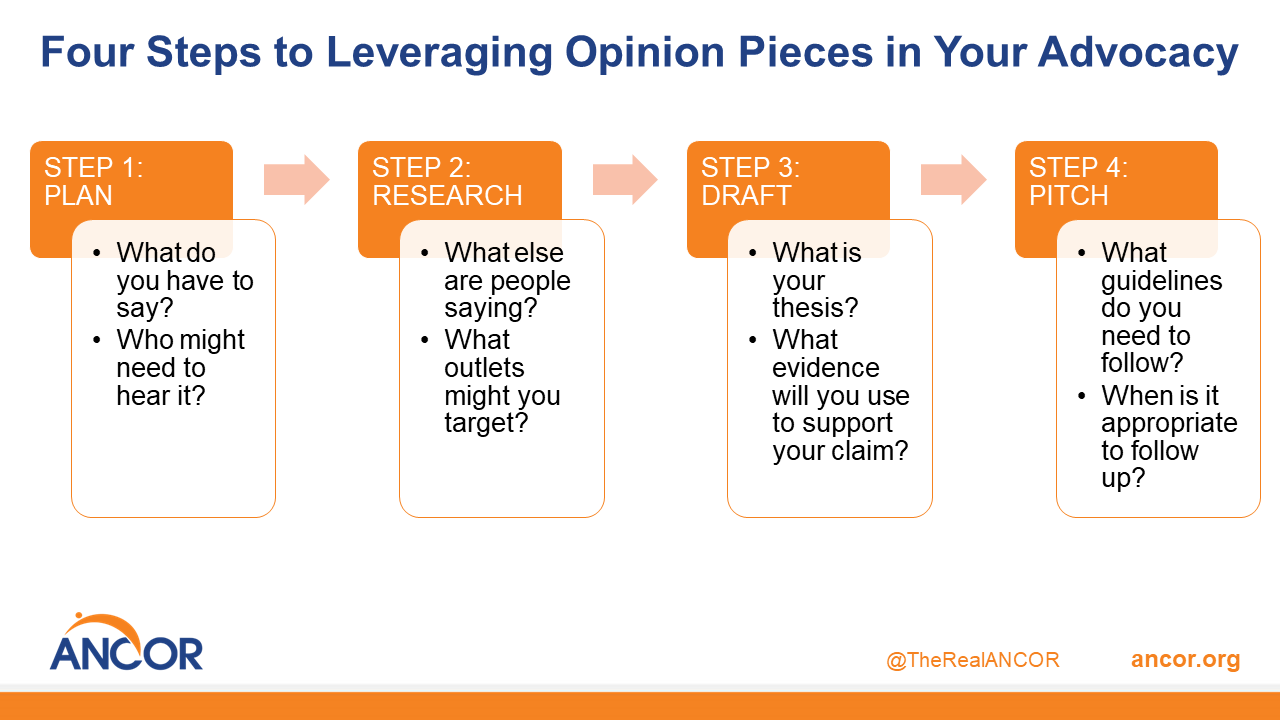Writing & Placing Opinion Pieces

Opinion pieces in the form of op-eds and letters to the editor are a great way to raise awareness about a problem or policy that is of interest to the readers of a particular news outlet. In the context of public policy advocacy, op-eds and letters to the editor can help lawmakers understand the need for action and build support for a particular course of action among lawmakers’ constituents.
The Basics
What is an op-ed?
Simply stated, an op-ed is a short essay articulating an opinion that is authored by a guest contributor and published by a media outlet, such as a local newspaper or a trade magazine.
Sometimes referred to as a guest essay, the term “op-ed” derives from where these essays would be published; in print newspapers, these guest contributions would typically be placed on the page OPposite the EDitorial page.
Op-eds are typically 500-750 words in length. Although not every news outlet welcomes op-ed submissions, those that do will have their own stated preferences and requirements regarding the desired length of op-ed submissions.
What is a letter to the editor?
Similar to op-eds, letters to the editor briefly articulate an opinion about a particular issue, typically voiced by a reader in reaction to the news outlet’s coverage of that issue.
Whereas op-eds tend to be 500-750 words, letters to the editor are usually much shorter—typically in the range of 150-250 words.
Because they take up fewer “column inches” (i.e., space in a print publication), outlets that welcome letters to the editor will generally publish a higher volume of these letters compared to their lengthier counterparts. That means that although letters to the editor don’t allow the amount of detail found in an op-ed, they can be easier to get published.
What are the markers of an effective opinion piece?
A good op-ed or letter to the editor will:
- Articulate an opinion that is unique, or founded on a uniquely valuable perspective, and well-evidenced.
- Capture and sustain the reader’s attention by employing an engaging hook and describing issues in a way that is concise and accessible.
- Be written from the perspective of someone who has credibility on the topic at hand, generally due to their expertise or lived experience.
- Call attention to a problem or issue that is relevant to—even if not necessarily obvious to—the news outlet’s audience.
- Be timely, articulating an opinion at a time when that opinion matters, such as when a legislative body is considering a particular bill.
The Process
There are countless considerations to keep in mind as you envision, craft and place your op-ed or letter to the editor. However, as the graphic above depicts, these can be distilled into four general steps in the process:
- Plan: The first step is to plan your message. What kind of outlets might be interested in what you have to say? What about your issue might be salient to their audience? Whom are you calling on to take action? What action might you call on them to take?
- Research: After your initial planning, but before you’re ready to start writing, you need to conduct some basic research. What is already being said in the media about the topic you’ve chosen to write about? Can you differentiate your message from others that have been published? Which outlet(s) do you plan to target, and what are their guidelines for submission?
- Draft: After doing your research, you’re ready to start drafting! How you approach will depend on whether you’re writing an op-ed or a letter to the editor; downloadable guides for both can be found below. Note that the drafting process also includes editing—editing yourself, but also seeking feedback from trusted colleagues or friends who can help you ensure your opinion piece is coherent and well-written.
- Pitch: During Step 2 (Research), you should have identified your target news outlet’s preferred method of submitting your letter to the editor or op-ed. Follow those instructions, and keep in mind that outlets want their content to be exclusive, so you should only submit your opinion piece to one outlet at a time. Follow up several days after submission if you don’t hear anything—if you still don’t hear back, or if they reject your submission, you are welcome to submit it to another outlet on your target list.
Detailed Guidance

Crafting Letters to the Editor
Helpful guidelines for crafting effective letters to the editor.

Crafting Op-Eds
Everything you need to put together an op-ed to support your advocacy.

Placing Your Opinion Piece
From start to finish, these tips and tricks will help you get your op-ed or letter to the editor published.
Refining Your Approach
Wanting to take your op-ed or letter to the editor to the next level? Ask yourself these questions:
- Have you buried the lede? “Burying the lede” is a term used to mean that something is written in a way that doesn’t immediately make obvious the “so what.” Ask yourself whether a reasonable person could conclude why they should care about your position by reading only the first few sentences.
- Have you properly established your credibility in the eyes of your likely readers? This might involve incorporating a personal story or anecdote, or including your professional experience in a short biography included at the end of your op-ed.
- Are you respecting your reader’s time and expertise? On the one hand, your opinion piece should be written to be accessible to people with less knowledge of the topic than you have. On the other hand, you don’t want to write in a condescending tone that assumes your reader isn’t intelligent. Avoid jargon, but don’t be afraid to dive deep into the details if space permits.
- Are you using inclusive language? Even those of us whose life work is to support people with disabilities can use phrases that are insensitive to the experiences of living with a disability. Consider whether your op-ed or letter to the editor reflects the respect you have for the group of people you’re writing about.
- Should you specifically name individual people who have the influence to bring about the change you seek? If done respectfully, naming explicitly the individuals you seek to influence can significantly enhance the odds that they see your opinion piece. For example, instead of calling on Michigan’s lawmakers to prioritize disability services in the state’s budget, you might instead call on Michigan Governor Gretchen Whitmer to prioritize funding for disability services. Consider both the potential rewards and potential risks of this approach.
Recommended Resources
There is a wealth of other information out there, both from ANCOR and other sources, about how to effectively craft and place an op-ed or letter to the editor. Here are just a few of the resources we recommend:
- The Op-Ed Project exists to change who writes history by building the capacity of underrepresented voices to take thought leadership positions in their respective industries. The Project’s website includes tips and tricks, guidance for pitching and more.
- In February 2024, we hosted a webinar called “Upping Your Advocacy Game on the Overtime Rule,” the recording of which includes guidance on how to craft and place an op-ed.
Sample Op-Eds
The following examples, which all articulate the need for support for I/DD services, help illustrate messages that were effectively published in the form of an op-ed.
- Medicaid Providers Need a More Sensible Approach to Labor’s Overtime Proposal
Barbara Merrill, The Hill - Will State Break its Promise to Those with Intellectual and Developmental Disabilities?
Barry Jardini, San Diego Union-Tribune - Workforce Crisis Stifles Effort to End Disability Waiting List
State Representative Ellyn Hefner, City News OKC - Congress Has Again Failed People with Disabilities — We Need Bipartisan Legislation Now
Barbara Merrill, The Hill - People with Disabilities Contribute Much to Society
Teresa Naughton, The Messenger
Have Questions? Need a Hand?
We’re here to help! If you would like assistance using any of the tools found on this page, or if you have questions about how ANCOR can support you to place your op-ed or letter to the editor, please email Sean Luechtefeld.

